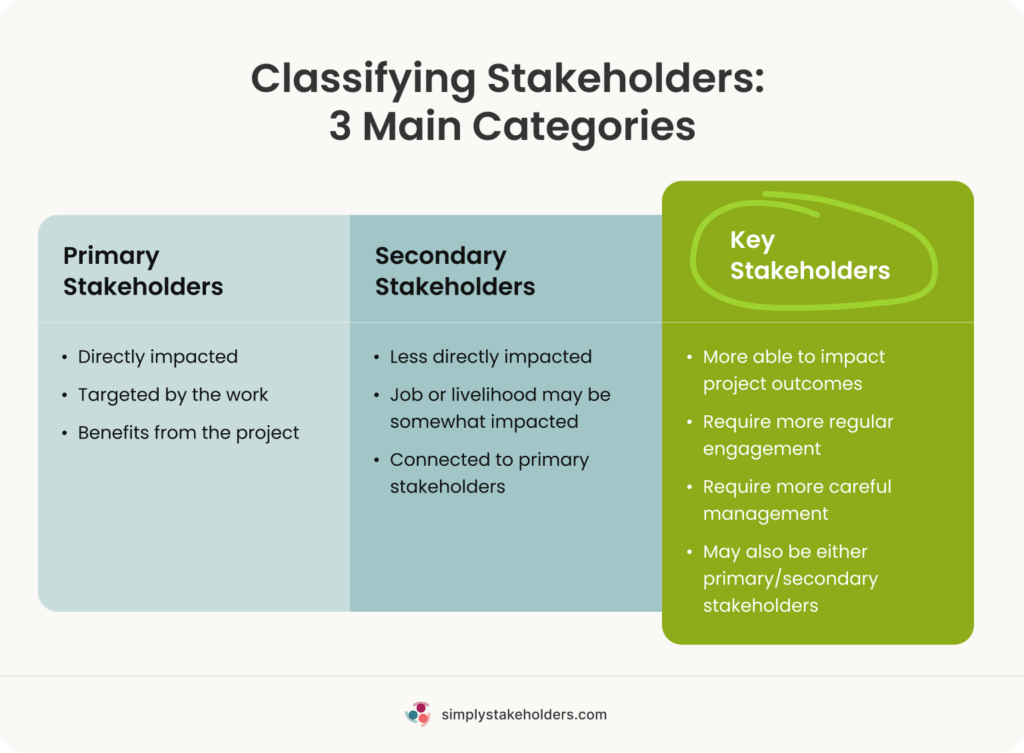Stakeholder Classification: Understanding The Essentials

Not sure where to begin with your stakeholder list? If you’ve identified your stakeholders, the next logical step is stakeholder classification!
Inside this short guide, we cover what stakeholder classification is, why it’s useful, and some of the different ways you may classify your stakeholders.
What Is Stakeholder Classification?
Stakeholder classification is the process of assigning a type or category to stakeholders in order to understand them, analyze them, and segment them. Following this process, organizations and project managers can more effectively plan and execute their stakeholder engagement or to manage their stakeholder relationships.
There are a number of stakeholder classification methods and processes you can follow, depending on the characteristics that matter for your project, and the tools you have access to. But some examples of classification you might come across include primary/secondary, internal/external, and risk/opportunity.
Why Is Stakeholder Classification Important?
Having access to a lot of data might seem like a really good thing at first, but there’s very little you can do with the data until you can organize it into a format you can analyze and use.
It’s the same with stakeholders. You can come up with a list of 50 stakeholders or 1000 stakeholders, but this information will be next to useless. No project has unlimited time or resources, and it’s not practical to engage with each stakeholder on an individual basis. In order to do anything with your stakeholders, you’ll first need to classify them. This can allow you to:
- Assign a rating or a level based on set characteristics (e.g. interest, influence, knowledge)
- Conduct stakeholder mapping to visualize all your stakeholders on a chart or matrix
- Analyze your stakeholder list so you can understand the big picture of what your data represents (e.g. do most stakeholders support your project or oppose it?)
- Organize your stakeholder lists into segments
- Tailor your communication and stakeholder engagement approach to different segments
- Prioritize your stakeholders based on their attributes (e.g. engage first or more frequently with the most impacted and most influential stakeholders)
- Begin to use the insights from your stakeholder analysis to take the next steps
Identifying Stakeholders to Classify

Before you can begin classifying your stakeholders, you’ll first need to identify your stakeholders and record them on your stakeholder list — you can do this in your stakeholder software or in a spreadsheet. Remember that a stakeholder is any person, group, or organization that may be impacted by, have an influence on, or an interest in your project or work.
As you identify your stakeholders, you may discover that you can already begin to classify them based on what you already know about them and the project. The most basic classifications are:
Primary Stakeholders
The most commonly accepted definition of a primary stakeholder is someone that is likely to benefit from or be targeted by the project or work. For example, a new road project may benefit the surrounding communities by connecting them to local facilities, or by reducing traffic congestion in the area. Or a new school in an underserved region will involve the local community, its students, and its teachers.
Secondary Stakeholders
Secondary stakeholders are still involved in or impacted by the project, but in a less direct way. Usually, their involvement is due to their relationship with or proximity to primary stakeholders. Or their day-to-day lives or jobs may be impacted by the project in some way. For example, the new road project might impact businesses that deliver services within the region (such as postal carriers), as well as local police officers, emergency services, town planners, and contractors. And the secondary stakeholders for a new school might include other nearby schools, social workers, bus drivers, developers, builders, and families of the school students and teachers.
Key Stakeholders
Key stakeholders are those that require more regular engagement and careful management due to their ability to influence the project outcomes or other stakeholders. These may come from either of your primary or secondary stakeholder groups. Depending on your project, key stakeholders often include regulators, government officials, and policymakers. But it may also include influential organizations (such as media groups), leaders within the local community, influential people within organizations, individuals that control your sources of funding, and any activists or advocates that others are likely to listen to.
Key Stakeholder Classification Models

So, how do you figure out who your key stakeholders are? There are many ways to classify stakeholders and target specific stakeholder characteristics that are relevant to your project or engagement. Here are some frameworks and models you could use for further stakeholder classification:
The Three I’s
Our favorite stakeholder classification framework (that is built into our stakeholder software product) is the Three I’s Method. It assigns a rating to the following for each stakeholder:
- Influence – What level of influence could this stakeholder exert on the project? (Low, Medium, High)
- Interest – What is their level of interest in the project? (Low, Medium, High)
- Impact – What level of impact may the project have on the stakeholder? (Low, Medium, High)
We also recently updated our framework to include three additional dimensions:
- Criticality – How critical is this stakeholder to the success of your project? (Low, Medium, High)
- Position – What is their position towards your project or work? (Very Negative, Negative, Neutral, Positive, Very Positive)
- Effort – How much effort will it take to engage them? (Low, Medium, High)
At the moment, we also give users the ability to use different labels or terms for these six criteria inside Simply Stakeholders (though we are always reviewing this and updating it based on user feedback). This means that if you wish to evaluate your stakeholders based on your own unique set of criteria, you can adapt our framework to suit your needs.
Grid-Based Models
When it comes to more simple stakeholder relationships, you may find some value from using a stakeholder matrix or grid-based model. The most commonly used ones include:
- Power-Interest Grid – Classifies stakeholders based on their level of power and interest
- Power-Predictability Matrix – Classifies stakeholders based on their level of power and predictability
- Stakeholder Knowledge Base Diagram – Classifies the stakeholders based on their degree of knowledge and degree of support
However, it’s important to be aware of the limitations of these models. They often lack context — after all, they only classify your stakeholders based on two dimensions. On top of this, power can be difficult to define and isn’t always a practical thing to measure or track, with the capacity of nearly anyone to wield some power thanks to social media platforms. It is unlikely that any grid-based method will be enough to categorize stakeholders without using some other framework, as well.
Salience Model
The salience model is one of the most popular methods of stakeholder classification. It works by placing stakeholders into one of seven categories (each with different priorities), based on whether they have high or low power, urgency, and legitimacy. The seven categories are as follows:
- Dormant
- Discretionary
- Demanding
- Dominant
- Dangerous
- Dependent
- Definitive
However, we do not recommend this approach for assessing and categorizing stakeholders. The first problem is the focus on power — as we’ve already mentioned, power is difficult to define in a modern stakeholder engagement since any stakeholder can hold enough power to influence outcomes. Secondly, some of the language used is highly outdated. Words like “dominant”, “dangerous”, “demanding”, and “dependent” could be considered offensive. Finally, the model excludes many other useful attributes, so risks oversimplifying the stakeholder classification process.
Stakeholder Cube
The stakeholder cube is a three-dimensional model for classifying stakeholders based on power, interest, and attitude. The model allows you to plot the level of each attribute on three axes of the cube, to pinpoint where stakeholders sit in relation to one another.
The cube is divided into eight smaller segments, each with varying levels of the three attributes, and each representing distinct categories with different requirements for communication and engagement. The segments include meet their needs, key players, keep satisfied, defend against, monitor, keep informed, potential risk, and least priority.
Although this model allows you to track three dimensions, it still lacks enough detail to make it useful on its own. And once again, we run into issues with classifying modern stakeholders based on power.
Direction of Influence
The Directions of Influence chart allows you to classify stakeholders into four different groups: upward, downward, outward, and sideward. The idea is to visualize the relationships between stakeholders and how they might influence others, shown using arrows, colors, shapes, and other visual elements. For instance, the team manager exerts downward influence over the team, but upwards influence towards managing the organization’s overall commitment. Meanwhile, an example of sideward influence could include relationships with peers, and outwards influence could refer to relationships with external stakeholders.
This model may have its place (like understanding the relationships within a given organization), but we believe there are better methods to classify stakeholders based on their relationships, such as relationship network mapping.
Prioritization
Finally, one simple method of stakeholder classification is to simply set priorities based on what you can realistically accomplish based on your limited time and resources. In some cases, you won’t be able to engage with every stakeholder on your list. However, you should first analyze your stakeholders before you can set your priorities.
By the way, you’ll find more tools inside our previous articles on stakeholder diagrams and stakeholder mapping methods.
Evaluating and Monitoring Stakeholder Classification

After you’ve classified your stakeholders, it’s important that you don’t just stop there. Use your findings to inform your stakeholder plans and carry out your engagement. But also monitor your stakeholders carefully, and update your classifications if needed. This may include:
- Adding new stakeholders as you discover them
- Removing old stakeholders that are no longer relevant
- Adding new information about stakeholders (e.g. changing interests, new relationships, or an increase in influence)
- Adjusting your priorities and associated tasks, as needed
- Updating your analysis to track changes as a result of your engagement (and adding these to your reports)
On top of this, we recommend that as part of your regular evaluation process, you also consider your approach to classifying stakeholders. Ask yourself questions like:
- Was my original stakeholder classification accurate?
- Was it helpful to categorize my stakeholders in this way?
- What other attributes or dimensions could I have looked at?
- What other methods or visualizations could I have tried?
- In future, what could I do differently to be more accurate, efficient, and effective?
You will almost certainly go through this process again in future — potentially with many of the same stakeholders in your list. So, noting down any learnings while they’re still fresh in your mind will help you continually improve your stakeholder classification process.
Master Stakeholder Classification With Simply Stakeholders
Stakeholder classification is one of the core skills to master in stakeholder management — it can help you transform your list of stakeholder data into something you can understand, plan around, and act upon. We encourage you to take some time to experiment with the different methods and find what works for you!
Looking for a tool to help you take a more professional and systemized approach to classifying stakeholders? Simply Stakeholders includes a range of practical, built-in capabilities that bring stakeholder data and lists to life through stakeholder analysis and mapping, allowing you to easily categorize your stakeholders. Best of all, our stakeholder maps are automatically refreshed as you add new stakeholder information, helping you keep your stakeholder classification current.
Learn more about how our software works or reach out to our team to request a demo!






























